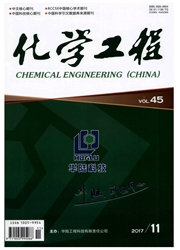

 中文摘要:
中文摘要:
气液反应界面传质的强化是当今高效和节能反应器研究的重要课题,弄清反应器内的气液传质机理是对气液反应器进行数学描述的关键。反应过程的能效和物效与体系中的传质系数kG,kL,kS以及相界面面积a等参数直接相关,这些参数受气泡尺寸、分布、表观气速和气含率等因素的制约。就确定的体系和反应条件而言,这些因素会因反应器的结构尤其是搅拌和混合方式的变化而异。文章从理论上分析了影响气液界面传质的各因素,建立了较为详细的理论模型。理论计算结果表明:气泡大小是影响气液界面传质和最终反应速率的重要流体力学参数,微米级气泡对反应过程的强化作用明显。能量耗散率是决定体系气泡大小的深层原因,强化气液反应器设计时应重点考虑。
 英文摘要:
英文摘要:
Intensification of interfacial mass transfer in gas-liquid system is an important issue to explore high efficiency and energy saving reactors. It is the key to well understand its mechanism of the gas-liquid mass transfer for mathematically describing of a gas-liquid reactor. Both energy and mass efficiencies of the reaction are directly related to the gas-liquid interfacial area a and mass transfer coefficients of kG( gas-side),kL( liquid-side) and kS( liquid-solid). These parameters are often restricted by size and distribution of the flowing bubbles,the gas holdup and the superficial gas velocity etc.,which can vary with the structural parameters of the reactor,particularly with those of mixing and stirring mode. Factors of gas-liquid interfacial mass transfer were theoretically analyzed and some mathematical models were set up. The theoretical results show that the bubble size in the reaction system affects the gas-liquid interfacial mass transfer and final reaction rate for a certain reaction system,and the micron bubbles have obvious intensification effect. Energy dissipation rate of the system is the deep reason for determining the dimension of the bubbles,which should be considered during the design of intensified gas-liquid reactor.
 同期刊论文项目
同期刊论文项目
 同项目期刊论文
同项目期刊论文
 期刊信息
期刊信息
